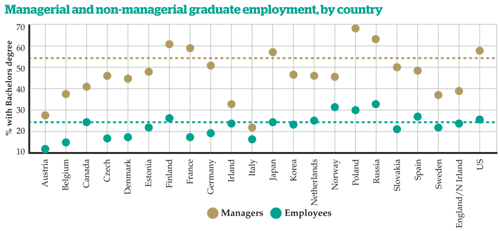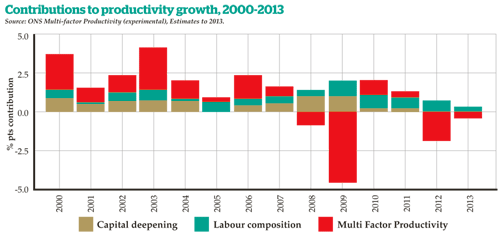New Higher Apprenticeships have been welcomed by employers and students, but they remain few in number. In fact, participation in the main vocational routes, such as Foundation Degrees and Higher Apprenticeships, do not make up even 10% of the level of participation in undergraduate degrees in England (Growth Through People: Evidence and Analysis - UKCES, 2014).
However, a higher skilled workforce and greater investment is no guarantee of productivity growth. What should also be taken into account is the ‘black box’ of factors that cannot be easily measured - this is also known as total factor productivity (TFP), and it has been in steady decline since the recession (see chart, below).
In short, it is a measure of how effective the economy is at turning labour and capital into outputs, and it covers factors such as the effective use of technology and innovation, the market’s ability to direct resources to the most efficient businesses, and the management and leadership of organisations. It is the latter of these in which we at UKCES are most interested.
Compared with a sample of major economies, the UK has a good share of businesses scoring in the top quartile for management practice. However, it also has a long tail of poorly managed firms, scoring in the bottom quartile (World Management Survey, 2004-2010 set).
One in five manager vacancies are hard to fill because of skills shortages (The UK Commission’s Employer Skills Survey 2013: UK Results. Evidence Report 81, UK Commission for Employment and Skills, Wath-upon-Dearne). And while most advanced economies have a large qualification gap between managers and employees, the UK has a much smaller one (see chart, opposite).
About a quarter of performance gaps between businesses can be attributed to differences in managers’ practices. Evidence in the US suggests that a manufacturing plant in the 90th percentile of the productivity distribution produces almost twice as much with the same inputs as the 10th percentile plant (What determines productivity? Journal of Economic Literature 2011, 49: 326-365).
If the UK’s productivity fall is at least in part explained by slacking TFP, then the high incidence of skills under-utilisation in the UK should also be investigated. More than one-third of employees in the UK have qualifications beyond those necessary to be hired for their current job, equivalent to about 11 million workers. It is possible to be overqualified but under-skilled. But even so, 15% are estimated to be both overqualified and over-skilled (Growth Through People: Evidence and Analysis - UKCES, 2014).
Paradoxically, given the UK’s relatively low share of workers with intermediate skills, those workers often find themselves doing work that is below the level for which they are qualified. If we are to raise the prospects of those with low skills, will our workplaces generate the job opportunities to make use of their improved skills?
Underutilisation has consequences. Employees unable to use the skills they have invested in are less likely to feel motivated, and as a result are less likely to make the discretionary commitment to make further efforts in the workplace. It all contributes to the productivity problem.
Alongside workers whose skills are not fully utilised, there are employers struggling to fill vacancies and employers whose workforce is not as skilled as they might wish.
Between 2011 and 2013, the Employer Skills Survey, carried out every two years by UKCES, found that while the number of overall vacancies increased by 12%, skills-shortage vacancies (a subset of vacancies, defined as “hard-to-fill” because of a lack of skills, work experience or qualifications in the candidates applying for a role) increased by 60%. Shortages comprise nearly a quarter of all vacancies, and tend to be concentrated in particular sectors and persist for long periods of time. These prevent employers from realising business goals and ambitions, and may hold back growth in productivity.
Across all occupations, the most common types of skills shortages relate to technical, practical or job-specific skills. These are best gained in a workplace setting, illustrating the critical role that employers must play in helping to overcome skills shortages. Shortages also focus on more generic skills such as problem-solving, planning and organisational, and customer-handling, as well as strategic management - all of which are best developed in the workplace.
The science, technology, engineering and mathematics (STEM) professional category has been among the worst affected occupational areas by skill shortages throughout this period, with an increasingly large share of STEM graduates immediately entering non-STEM roles. And the science, research, engineering and technology professional category has the highest density of skill shortages of any of the 25 occupational groups. At 43% it is almost twice as high as the overall average of 23%, and at 13,000 is the third highest of the occupational groups in terms of overall volume of shortages (Growth Through People: Evidence and Analysis - UKCES, 2014).
Skills gaps are much more widespread than skills shortage vacancies, with 15% of establishments reporting a skills gap and a total of 1.4 million employees missing the skills necessary to fulfil their job requirements (The UK Commission’s Employer Skills Survey 2013: UK Results. Evidence Report 81, UK Commission for Employment and Skills, Wath-upon-Dearne).
Around three in ten gaps are attributed to staff not having received appropriate training, while two-fifths are due to workers’ skills remaining inadequate after receiving training. In many sectors, little more than half of employees receive training, and even then for many it is a relatively small amount.
Four in ten employers recognise they should train more (The UK Commission’s Employer Skills Survey 2013: UK Results. Evidence Report 81, UK Commission for Employment and Skills, Wath-upon-Dearne). Again, having employees in roles that they cannot perform proficiently adversely affects the productivity of businesses up and down the country. In our efforts to solve the productivity puzzle, skills are by no means a simple or single solution. Investment, better use of technologies, competitive markets and planning all have a role to play. What is clear, however, is that what happens in the workplace matters to us doing more and doing it better. How we develop, deploy and retain the skills and capabilities of people all matter in untangling the track.
 Read the peer reviews for this feature.
Read the peer reviews for this feature.
Download the graphs for this feature.












